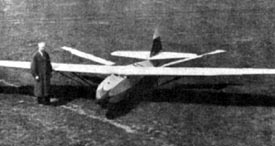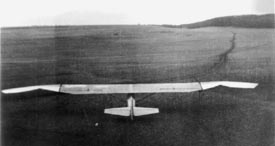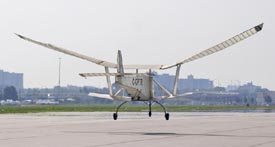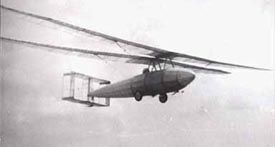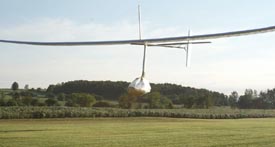 |
 |
Manned Ornithopters Full History History Archive
Getting Started How to Design & Build Competition Info Design Tools
Design Manual Newsletter Free Plans
Teachers Guide Web Site Links
About the Society Contact Info |
Manned Ornithopter Flights Often people think of ornithopters as a relic from the early days of aviation. I would like to present a different view. Successful flapping-wing flight actually requires more technology than the simple airplane. The current, rapid progress in this field means the ornithopter will see its greatest development in the future, not in the past. It is important to realize that most ornithopter work is not aimed at producing manned aircraft. There are probably more practical applications for unmanned ornithopters. The main reason to build a manned ornithopter is because of the technical challenge. It is why people climb mountains and why the peacock has such an elaborate tail. Perhaps for that reason, most people who build manned ornithopters try to use their own muscle power to flap the wings. It works a lot better if you use an engine. With further development, the ornithopter should offer excellent fuel economy, coupled with the ability to take off and land vertically. On the other hand, the ornithopter is inherently complex, and that might prevent its widespread application as a means of human transport. In either case, further research will expand our knowledge and expertise in the field of aeronautics. People often associate ornithopters with Leonardo da Vinci, the Renaissance artist who sketched some ideas for flapping-wing machines. Really, the idea of a flapping-wing aircraft goes back to ancient times. Ornithopters were depicted in ancient Assyrian stone carvings, circa 1000 BC. The Hindu epic Ramayana (5th century BC) describes an ornithopter powered by biofuels. Actual flight attempts were made well before Leonardo's time, some resulting in short glides. But it was not until 1942 that the first person made a lengthy flight in an engine-driven, flapping-wing vehicle. Alexander Lippisch A capable engineer, Lippisch would later design the world's first rocket-powered fighter plane, the Me 163 Komet. Lippisch was intrigued by the flapping-wing flight attempts of a Dr. Brustmann. Brustmann's machine did not fly, but as a medical doctor he had actually measured the amount of power that could be obtained from a person's arm and leg muscles. Lippisch accepted the challenge to design an aircraft that could be driven solely by the muscles of the pilot. He chose flapping wings because of their potentially greater efficiency compared with the airplane concept. Lippisch constructed an ornithopter and began tests. A young pilot and athlete, Hans Werner Krause, was selected to fly this machine. Since a small engine could have done the job better, he didn't feel inclined to expend much effort. Lippisch promised Krause a vacation if he could reach a predetermined mark at about 250-300 meters from launch. The goal was achieved. [Ref. 1]
Although Lippisch declared the flight a success, some other people competing for the claim of first manned ornithopter have expressed their doubts. One argument is that the Lippisch ornithopter did not have enough wing area to fly on muscle power alone. If you know the wing area, coefficient of lift, etc. then you can calculate the power requirment. However, we can only guestimate some of the variables. Another problem is that the ornithopter was launched using an elastic cord. The cord imparted a certain amount of energy, which got the ornithopter off the ground and got it up to speed. You can launch an unpowered glider in this way. If the launch speed is higher than the stall speed or minimum flying speed, then the aircraft can continue for some distance without losing any height. In such a case, the aircraft speed would decrease throughout the flight as kinetic energy is used to keep the aircraft aloft. To demonstrate a truly "sustained" flight, one would need to show that the speed and height are both maintained for some distance. We simply don't have enough documentation to know if that was the case. Lippisch continued his ornithopter research. He and his students in the 1930s constructed a whole series of engine-powered, unmanned ornithopters. Generally they used small flappers in conjunction with larger fixed wings (not totally fixed because the whole machine would move up and down in reaction to the flapping). This meant they didn't need as much gear reduction, so the machines were easier to build. The flapper designs were backed up by extensive laboratory testing and theory. The longest flight on record was over 16 minutes! At the same time, the Muscle Flight Institute under Oskar Ursinus was acquiring more information on human muscle power. They found that a person using arms and legs together could produce over 1 horsepower in a short burst. Also significantly, the athletes could produce the greatest amount of power when working their muscles at about 1.7 cycles per second. For ornithopters, the flapping rate is related to the size of the wings. For the wings to operate at 1.7 Hz, they had to be smaller than what would be required to support a manned aircraft. [Note 1] The answer was found in Lippisch's small-flapper configuration. The small flapping wings could operate at 1.7 Hz, and a separate fixed wing could provide most of the lift. Adalbert Schmid
On June 26th, 1942, Schmid's ornithopter shown here made a flight of 900 meters at a constant 20 meters above the ground near Munich. The pilot, Mueller, also supplied the power to flap the wings. This ornithopter still relied on a tow launch. However, Schmid went beyond the limitations of muscle-powered flight by putting an engine in this ornithopter. [Ref. 2] With a 3 hp Sachs motorcycle engine, the ornithopter was able to take off unassisted from the ground. Schmid's ornithopter may have used a dolly with wheels that could be jettisoned after takeoff. This practice was commonly used in early glider type aircraft and was also used by Lippisch in the Me 163. Schmid's ornithopter made a quiet 15-minute flight at about 60 kilometers per hour. Then a 6 hp engine was installed, increasing the speed to 80 kph. After these historic accomplishments, Schmid's work was interrupted by the war. By 1947, however, Schmid had built a second ornithopter. This one, a modified Grunau-Baby IIa sailplane, was constructed with flapping outer wing sections. Using a 10 hp engine, this double-seater was capable of speeds estimated at 100 to 120 kilometers per hour. [Ref. 3]
James DeLaurier The use of an engine with appropriate gearing would enable progressively more of the wing area to be flapping. Birds get some lift from the body and tail, but the flapping wings are comparatively large. A team at the University of Toronto Institute for Aerospace Studies, led by James DeLaurier, constructed an ornithopter in the 1990s which had comparatively smaller fixed wing area. This ornithopter made a 14-second flight in 2006. It was assisted by a small jet engine, but the flapping wings did most of the work. [Ref. 4] One of the problems
encountered during this project was that the aircraft tended to
bounce on takeoff, due to the flapping of the wings. The jet assist
allowed a smoother takeoff and helped compensate for the added weight
of a rebuilt undercarriage.
Vladimir Toporov Percival Hopkins Spencer had proposed a four-winged ornithopter design, which would provide a smoother ride for the occupants of the ornithopter. He demonstrated the concept in 1960 with the world's first successful radio-controlled ornithopter. The proposed manned ornithopter was not built. In the mid-1990s, however, Vladimir Toporov tested a human-powered ornithopter with four flapping wings. The four-winged ornithopter design showed it is possible to greatly reduce the body oscillation, an important step toward a practical manned aircraft. Toporov's ornithoper is significant for another reason. With much greater wing area, and the greatly improved efficiency of the four-winged design, it is quite likely that this aircraft sustained flight with muscle power alone, rather than relying on the energy of the tow launch. Todd Reichert The University
of Toronto Institute for Aerospace Studies followed its manned,
engine-powered ornithopter attempt with a human-powered ornithopter
called the Snowbird. The project was led by Todd Reichert. The human-powered
ornithopter was designed to have a large wing area, in order to
minimize the power requirement. It was powered by a leg-press motion,
and only the outer portions of the wings were made to flap, thus
addressing the need to match the flapping rate with the optimal
rate of cycling the muscles. As with previous human-powered ornithoper
attempts, the Snowbird relied on a tow launch. [Ref. 5] I
had suggested to Reichert that in order to document a sustained
flight, he would have to measure not just the height, but also the
speed of the aircraft, over time. These measurements are difficult
to make, and Reichert went to great lengths to collect the required
data. Unfortunately, I failed to anticipate one serious problem.
The wing flapping causes a cyclical fluctuation in both the height
and speed of the aircraft. Thus, it was still difficult to assess
whether a sustained flight was made.
Reichert erroneously
added the downstroke energy gain, which is cyclical and temporary,
to the total flight energy when evaluating whether the total energy
was maintained. As a result, he falsely claimed that a 19.3 second
sustained flight had been made. In reality, his own data show that
the duration of sustained flight was somewhat shorter. Reichert
also claimed that his human-powered ornithopter was the first to
sustain flight. Even if there is some uncertainty in the prior claims,
it cannot be stated with any confidence that Reichert was the first
to sustain flight in a human-powered ornithopter. Regardless of
who was the first to sustain flight, when a human-powered ornithopter
finally takes off under its own power, instead of using a tow launch,
that will be a truer measure of success. Notes: 1. I'm simplifying this complex issue somewhat. Large wings are required only if power is to be minimized. And the flapping rate is not entirely determined by the size of the wings. References: 1.
Lippisch, Alexander. "Man Powered Flight in 1929" Journal
of the Royal Aeronautical Society. July 1960.
|
|||||||||||||||||||||||||||||||
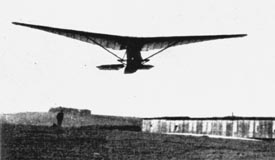
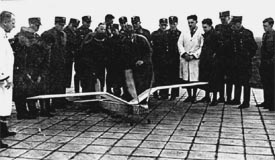
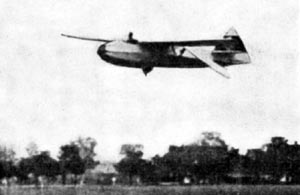 Because
his talents were needed in the war effort, Lippisch was not able
to continue his ornithopter work. Therefore it was Adalbert Schmid
who constructed the small-flapper manned ornithopter that seemed
to follow logically from what had been done so far.
Because
his talents were needed in the war effort, Lippisch was not able
to continue his ornithopter work. Therefore it was Adalbert Schmid
who constructed the small-flapper manned ornithopter that seemed
to follow logically from what had been done so far.